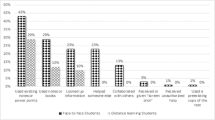Abstract
This paper provides a model for testing the relation between a particular action (cheating) and ethics education. The test is for a difference in the incidence of cheating (answer copying) between two groups: students who have and students who have not taken a course in ethics. The model facilitates testing by obtaining a relation between the unobservable variable (cheating) and an observable variable (a wrong answer on the target question which is the same as the answer of a nearby student). The required sample size is large but roughly comparable to the size that has been used with an answer copying index. Unlike an answer copying index, the model does not rely on extensive copying by individual students. The model is best suited for faculty who use in-class, multiple-choice exams.
Similar content being viewed by others
References
Angoff, W. (1974). The development of statistical indices for detecting cheaters. Journal of the American Statistical Association, 69, 44–49.
Bay, D., & Greenberg, R. (2001). The relationship of the DIT and behavior: a replication. Issues in Accounting Education, 16(3), 367–380.
Beggs, J., & Dean, K. (2007). Legislated ethics or ethics education?: Faculty views in the post-Enron era. Journal of Business Ethics, 71, 15–37.
Bellezza, F., & Bellezza, S. (1989). Detection of cheating on multiple-choice tests by using error-similarity analysis. Teaching of Psychology, 16(3), 151–155.
Bloodgood, J., Turnley, W., & Mudrack, P. (2008). The influence of ethics instruction, religiosity, and intelligence on cheating behavior. Journal of Business Ethics, 82, 557–571.
Bok, D. (1976). Can ethics be taught? Change Oct., 26–30.
Greenberg, J. (2002). Who stole the money, and when? Individual and situational determinants of employee theft. Organizational Behavior and Human Decision Processes, 89, 985–1003.
Lewis, P. (1985). Defining ‘business ethics’: like nailing Jello to a wall. Journal of Business Ethics, 4, 377–383.
Malinowski, C., & Smith, C. (1985). Moral reasoning and moral conduct: an investigation prompted by Kohlberg’s theory. Journal of Personality and Social Psychology, 49(4), 1016–1027.
Mayer-Sommer, A., & Roshwalb, A. (1996). An examination of the relationship between ethical behavior, espoused ethical values and financial performance in the U.S. defense industry: 1988–1992. Journal of Business Ethics, 15, 1249–1274.
Mayhew, B., & Murphy, P. (2009). The impact of ethics education on reporting behavior. Journal of Business Ethics, 86, 397–416.
McKendall, M., DeMarr, B., & Jones-Rikkers, C. (2002). Ethical compliance programs and corporate illegality: testing the assumptions of the corporate sentencing guidelines. Journal of Business Ethics, 37, 367–383.
Nathanson, C., Paulhus, D., & Williams, K. (2006). Predictors of a behavioral measure of scholastic cheating: personality and competence but not demographics. Contemporary Educational Psychology, 31, 97–122.
Sotaridona, L., & Meijer, R. (2003). Two new statistics to detect answer copying. Journal of Educational Measurement, 40(1), 53–69.
Swanson, D. (2004). The buck stops here: why universities must reclaim business ethics education. Journal of Academic Ethics, 2, 43–61.
Trevino, L., Weaver, G., & Brown, M. (2008). It’s lovely at the top: hierarchical levels, identities, and perceptions of organizational ethics. Business Ethics Quarterly, 18(2), 233–252.
van der Linden, W., & Sotaridona, L. (2006). Detecting answer copying when the regular response process follows a known response model. Journal of Educational and Behavioral Statistics, 31(3), 283–304.
Waples, E., Antes, A., Murphy, S., Connelly, S., & Mumford, M. (2009). A meta-analytic investigation of business ethics instruction. Journal of Business Ethics, 87, 133–151.
West, T., Ravenscroft, S., & Shrader, C. (2004). Cheating and moral judgement in the college classroom: a natural experiment. Journal of Business Ethics, 54, 173–183.
Wollack, J. (1997). A nominal response model approach for detecting answer copying. Applied Psychological Measurement, 21(4), 307–320.
Acknowledgment
I thank two anonymous reviewers for helpful comments. The views in this manuscript are mine and are not necessarily the views of any organization with which I am affiliated.
Author information
Authors and Affiliations
Corresponding author
Rights and permissions
About this article
Cite this article
Liebler, R. Action and Ethics Education. J Acad Ethics 8, 153–160 (2010). https://doi.org/10.1007/s10805-010-9114-z
Published:
Issue Date:
DOI: https://doi.org/10.1007/s10805-010-9114-z




